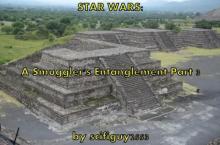- Home
- scifiguy3553
“ 3 5 5 1 : The Burden Of Earth’s Children. ”
“ 3 5 5 1 : The Burden Of Earth’s Children. ” Read online
“ 3 5 5 1 : The Burden Of Earth’s Children. ”
The Jorus crew, under Captain Alund Reinholm, is a transfer, intra-solar ship in the 36th century of planetary immigrants. With planet Earth's oceans and seas literally dried up, the Human species develop a controversial lottery system that takes many of these migrants to Mars, Europa, and Titan.
After a mutiny aboard the Jorus, the real reason behind the dreaded system is revealed...and a millennia of solar-governance is toppled!
…..........................................................
Jorus, the leviathan interplanetary ship, left Europa nearly a year ago and was now reaching Earth-proper. It was the year 3551, and Humans still mainly lived on the once-blue planet. The population of the colonies on Mars, Europa, and Titan all totaled over 1.1 million people—most of them, over three-quarters of a million, on Mars. The second largest grouping, approximately one-third of a million, lived on Europa. Just a couple of thousand settled on Titan. Considering that humans had been a space-faring species for over a thousand five hundred years, that was a lot of eggs to put into one basket after so many years!
That basket, of course, being Earth.
Captain Alund Reinholm and his crew of 1,000 were trekking to the human homeworld. It was hard for Reinholm and his crew to believe that their small, but modern, societies had actually been an offshoot of the pathetic planet. The dried out third planet from the Sun was now more like, as an ancient phrase went, a third world!
The immense oceans that had once swathed the planet were now dried, cracked seabed exposed to the hot atmosphere. There were some large bodies of water on Earth, but those were now the size of some of Earth’s largest seas of the days of old! Quite a far cry from the expansive Pacific and Atlantic Oceans from the history books. Hundreds of years ago, the scientists on Mars (at that time, the only colony outside of Earth) had warned the scientists on Earth and their governments against planet-wide, seawater conversion technology.
Humans constructed thousands of seawater conversion plants throughout Earth’s oceans and seas so the Earthen populace could utilize the undrinkable water. This was because the humans had over-consumed the freshwater they did have on Earth, about a thousand years ago. Back then, freshwater was only about two percent of the Earth’s share of water on the whole planet. Given the billions of humans that inhabited Earth back then, along with their insatiable use of freshwater, it was inevitable that the consumable water ran out. Hence, the seawater conversion plants.
But hundreds of years later just as the Martians predicted, the oceans and seas on Earth were sucked dry by the conversion plants. As if that weren’t bad enough, humans had continued to artificially warm the planet’s biosphere, which, of course, made the evaporation of water occur at a faster rate than normal—which sped up the vanishing of Earth’s fresh- and saline-waters. As a result, Earth’s population gradually plummeted. From its height in the 22nd century of around eleven billion people, by the time the 30th century rolled in Earth’s population leveled off to around five billion. And even then, the population of Earth fluctuated because of wars, natural disasters, and diseases. Some in Captain Reinholm’s generation estimated Earth’s population to be closer to four billion.
All the same to the captain and his crew, billions of impoverished Earthens still was a lot bigger than the barely one million colonists away from Earth! Captain Reinholm and his crew had been transporting tens of thousands back to Europa with them for the past six years, though the dispersion program had been going on for about forty-seven years. Scientists, actuaries, and governmental officials had done the calculations: in order for just one of the planetary (or lunar) colonies to come up with one hundred million Earthen immigrants within fifty years, there would have to be two million Earthens transported every year, for that fifty year stretch…and that was just for one of the colonies! The redistribution program was not planned to run concurrently, given the different stages of terraforming that Mars, Europa, and Titan were each undergoing.
Mars, the most settled of the three solar-colonies since it was the closest to Earth and with the best ecological conditions for humans, was the first to be used under the program. In its pre-colonial era, Mars’ atmosphere had an average temperature around –81 degrees Fahrenheit and an atmospheric pressure that was only a fraction of a fraction to that of Earth’s. But with extra oxygen, nitrogen, and carbon dioxide—which also helped to warm up the planet, added to its biosphere, within a century Mars was a lot like living on Earth’s Polar region on their warmest days! During Captain Reinholm’s generation, Mars still had several more millions to go to reach their quota, so the Martians were still shipping their fellow humans to their red planet.
And for the past few years Europa had been added to the program as the Jovian moon’s new atmosphere and climate finally reached a point of sustainability for a few million more humans added to its biosphere. Pre-colonial records had showed Europa to have an average temperature of –230 degrees Fahrenheit while its planetary pressure was laughable—something like one hundred billionth of that of Earth’s! But since Europa at least had traces of molecular-oxygen in it’s atmosphere, humans were able to terraform the once-icy planetoid into a living biosphere. Even during the days of Captain Reinholm’s generation Europa still had a very low atmospheric pressure. It was a characteristic of the moon that was not likely to ever go away, even when the terraforming process would be completed.
Titan, by far the least hospitable with its –289 degree Fahrenheit average temperature in its pre-colonial days and its atmospheric pressure around 60 percent stronger than Earth’s, was yet in the process of terraforming. If the Titanian collective wanted to ship over a few thousand Earthens, they could. But that would be all they could help facilitate from Earth. Just to be safe, and at the suggestion of their scientists, the Titan Collective decided to wait another ten to twenty years before they took on any Earthens.
But the long-term goal was for each solar-colony to sustain a population of around one hundred million people from Earth meant that Mars, Europa, and Titan all needed to ‘grow up,’ as it were, as planets; even Europa and Titan, being that they were moons of Jupiter and Saturn, respectively.
“She’s looking browner every time that we come here, isn’t she,” Captain Reinholm commented to his second-in-command; his eyes staying on the monitor as it displayed an image of Earth and it’s moon. He and his crew worked for the Europa Collective. It was a semi-governmental body of coordinated efforts by the various colonies on Europa. They came together when a need warranted an alliance.
“I can’t help but feel hopeless, sir,” Ester Kolnan shared. She stood next to the captain as the two readied their crew for landing procedures. “How did the Martian Collective do this past round?”
The captain grimaced at her question. “Well, let’s just say they had virtually every square inch in their ship filled with Earthen immigrants.”
“How many,” she curtly asked.
“Eighty-seven thousand!”
Commander Kolnan’s head snapped in her captain’s direction, out of disbelief. “How were they able to squeeze in seven thousand more?”
“I’ve no idea…probably took out some furniture and made extra space for them.” Reinholm shrugged.
The crew was busily working their machine terminals so the descent to their destination could begin. Finally, t
hey were entering the Earth’s atmosphere with their 1,500 foot long Jorus. There was some turbulence, but the landing phase in their mission was off to a good start. The immense curving horizon still had some wisps of clouds, and as the Jorus past through them, Earth’s drought-stricken landscape flashed right before the crew’s eyes. What was the Atlantic Ocean was now an ocean of ugly, brown dirt that seemingly went on forever! In truth, there were puddles of water on the expanse of the ocean floor. But the little ponds that were there were merely the size of football fields, some even less. But being within such great scale of desert, such ponds did not register with the human eye upon entering Earth.
The Jorus finally lowered to their rendezvous point. It was one of those blasted desalinization plants that helped turn Earth to its prune-like state. Like most of the water conversion plants dotted across the Earth, this facility had been decommissioned for at least a hundred years and now served as a spaceport, where, for over forty-five years, tens of thousands of humans had congregated and embarked on space vehicles that carried them to Mars. And now the solar system-port was servicing one-way departures for Europa. And

 “ 3 5 5 1 : The Burden Of Earth’s Children. ”
“ 3 5 5 1 : The Burden Of Earth’s Children. ” "Galactic Quest: A Star Wars Fandom Fiction."
"Galactic Quest: A Star Wars Fandom Fiction." "Operation Thunderclap"
"Operation Thunderclap" "When Universes Collide: A Star Wars Fan Fiction"
"When Universes Collide: A Star Wars Fan Fiction" "When Universes Collide--REVELATIONS: A Star Wars Fan Fiction"
"When Universes Collide--REVELATIONS: A Star Wars Fan Fiction" "Cousin Josh"
"Cousin Josh" "When Universes Collide--PADAWAN RECRUIT: A Star Wars Fan Fiction"
"When Universes Collide--PADAWAN RECRUIT: A Star Wars Fan Fiction" "When Universes Collide: A Star Wars Fan Fiction--COMPILATION”
"When Universes Collide: A Star Wars Fan Fiction--COMPILATION” “Star Wars: A Smuggler's Entanglement. Part III of III.”
“Star Wars: A Smuggler's Entanglement. Part III of III.” "Normal-PARA"
"Normal-PARA" “The Caregiver”
“The Caregiver” “STAR WARS: A Smuggler’s Entanglement: COMPILED!"
“STAR WARS: A Smuggler’s Entanglement: COMPILED!" "E-Normal: Ten Paranormal Ebooks--COMPILED!"
"E-Normal: Ten Paranormal Ebooks--COMPILED!" “Star Wars: A Smuggler's Entanglement. Part I.”
“Star Wars: A Smuggler's Entanglement. Part I.”